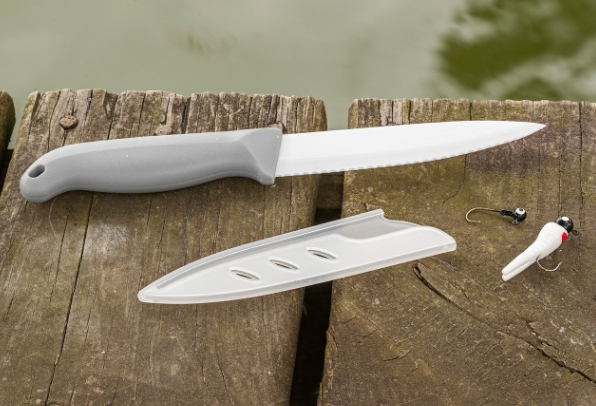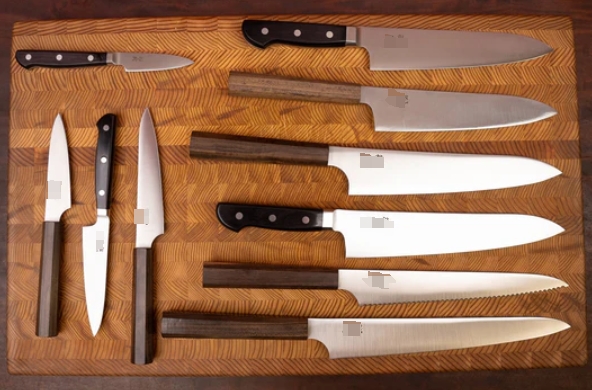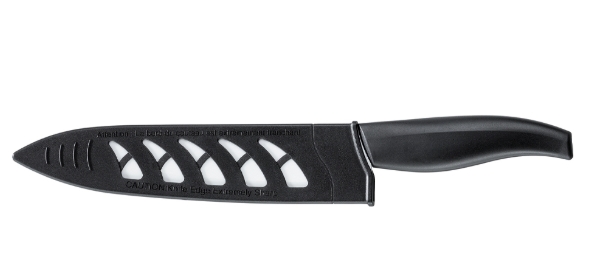

Views: 222 Author: Ella Publish Time: 2025-04-27 Origin: Site








Content Menu
● Understanding the Basics of Steel Types in Chef Knives
● Key Differences Between Carbon Steel and Stainless Steel Chef Knives
>> 1. Edge Retention and Sharpness
>> 2. Corrosion Resistance and Maintenance
>> 3. Toughness and Durability
● Practical Considerations for Choosing Your Chef Knife
>> Who Should Choose Carbon Steel?
>> Who Should Choose Stainless Steel?
● How to Care for Carbon Steel and Stainless Steel Knives
>> Carbon Steel Knife Care Tips
>> Stainless Steel Knife Care Tips
● Additional Insights on Carbon Steel and Stainless Steel Knives
>> The Patina: A Unique Feature of Carbon Steel
>> Stainless Steel: Innovation and Variety
>> Environmental and Usage Factors
● FAQ: Carbon Steel vs Stainless Steel Chef Knives
>> 1. Which knife type holds its edge longer?
>> 2. Are carbon steel knives safe to use with acidic foods?
>> 3. How often should I sharpen carbon steel knives compared to stainless steel?
>> 4. Can I put my chef knife in the dishwasher?
>> 5. How do I prevent rust on my carbon steel knife?
Choosing the right chef knife is essential for any cook, whether professional or home-based. Among the most debated topics in the culinary world is the choice between carbon steel and stainless steel chef knives. Both materials have unique characteristics, advantages, and drawbacks that affect performance, maintenance, and longevity. This comprehensive article explores the differences between carbon steel and stainless steel chef knives, helping you make an informed decision for your kitchen.

Carbon steel is primarily an alloy of iron and carbon, typically containing between 0.5% to 1.5% carbon, with minimal amounts of other elements. This composition allows carbon steel knives to be very hard and capable of holding an extremely sharp edge. However, carbon steel lacks significant chromium content, which means it is prone to rust and corrosion if not properly maintained.
Stainless steel contains iron, carbon, and at least 10.5% chromium, which forms a protective oxide layer that makes the steel resistant to rust and staining. Stainless steel knives are generally easier to maintain and more resistant to moisture and acidic foods. However, they usually have slightly less edge retention compared to carbon steel knives.
| Feature | Carbon Steel | Stainless Steel |
|---|---|---|
| Composition | Iron + Carbon (0.5-1.5%), very little chromium | Iron + Carbon + ≥10.5% Chromium |
| Edge Retention | Superior; holds edge longer and sharper | Good but generally less than carbon steel |
| Sharpness | Can be sharpened to a finer edge | Sharp but not as fine as carbon steel |
| Corrosion Resistance | Poor; prone to rust and patina formation | Excellent; resists rust and staining |
| Maintenance | Requires regular cleaning, drying, and oiling | Low maintenance; easy to clean |
| Durability | Tough but can chip if misused | Durable and resistant to chipping |
| Cost | Generally less expensive | Usually more expensive |
| Appearance Over Time | Develops a patina giving a rustic look | Retains shiny, polished appearance |
Carbon steel knives are renowned for their ability to achieve and maintain an extraordinarily sharp edge. Their hardness (often rated between 58-65 on the Rockwell scale) allows them to hold this edge longer than most stainless steel knives. This makes them ideal for precision tasks like filleting fish or finely dicing vegetables.
Stainless steel knives, while capable of sharpness, generally do not reach the same level of edge retention. They may require more frequent sharpening, especially with prolonged use.
The biggest practical difference lies in corrosion resistance. Stainless steel's chromium content forms a protective layer that prevents rust and staining, making these knives ideal for busy kitchens and less meticulous users.
Carbon steel knives, in contrast, are susceptible to rust and discoloration if exposed to moisture or acidic foods without proper care. They develop a patina-a thin layer of oxidized metal-that can protect the blade but also changes its appearance. Maintaining carbon steel knives requires immediate cleaning, thorough drying, and occasional oiling with food-safe mineral oil to prevent rust.
Carbon steel is tougher and less brittle than some stainless steels, which can make it more resistant to chipping under heavy use. However, improper heat treatment can make carbon steel brittle. Stainless steel knives tend to be more flexible and less prone to chipping but may wear down faster in terms of edge retention.
Carbon steel knives are easier to sharpen due to their composition and hardness. They can be honed to a very fine edge with less effort. Stainless steel knives, especially those made from high-alloy steels, can be harder to sharpen and may require professional sharpening tools.

- Professional chefs and serious home cooks who value sharpness and edge retention above all.
- Users willing to invest time in maintenance (cleaning, drying, oiling).
- Those who appreciate the aesthetic character of a patina and the traditional feel of carbon steel knives.
- Casual cooks or busy kitchens where low maintenance is a priority.
- Users who prefer a knife that resists rust and staining without extra care.
- Those who want a durable, corrosion-resistant knife that performs well in everyday tasks.
- Always hand wash immediately after use with mild soap and dry thoroughly.
- Avoid soaking or leaving the knife wet to prevent rust.
- Apply a thin layer of food-grade mineral oil regularly, especially after cutting acidic foods or prolonged storage.
- Store knives in a dry place, ideally in a knife block or sheath.
- Stainless steel knives are dishwasher safe but hand washing is recommended to preserve the edge.
- Dry after washing to maintain the blade's finish.
- Sharpen as needed, though less frequently than carbon steel knives.
One of the most distinctive aspects of carbon steel knives is the development of a patina over time. This natural oxidation process darkens the blade, creating a protective layer that helps resist further rusting and corrosion. The patina also adds a unique aesthetic, often prized by chefs who appreciate the character and history it imparts to their tools.
This patina can vary in color from a subtle gray to a deep blue-black, depending on the foods cut and the knife's exposure to moisture and acids. While some may see it as discoloration, many consider it a badge of honor, symbolizing a well-used and well-loved blade.
Stainless steel knives come in many varieties, ranging from entry-level kitchen knives to high-end blades made from specialized alloys such as VG-10, AUS-10, or high-carbon stainless blends. These steels aim to combine the corrosion resistance of stainless steel with improved edge retention and hardness.
Manufacturers often engineer stainless steel knives with advanced heat treatments and coatings to enhance performance. Some models feature layered Damascus patterns, combining aesthetics with functional benefits like improved strength and edge stability.
The choice between carbon steel and stainless steel can also depend on environmental factors and cooking styles. For instance, in humid or coastal environments, stainless steel knives are less likely to suffer from rust, making them more practical.
Conversely, for cooks who perform delicate slicing or require extreme sharpness, carbon steel knives offer unmatched precision. However, they must be vigilant about cleaning and drying to avoid damage.
Choosing between carbon steel and stainless steel chef knives depends largely on your cooking style, maintenance willingness, and preference for blade performance. Carbon steel knives offer superior sharpness, edge retention, and a unique patina but require diligent care to prevent rust and corrosion. Stainless steel knives provide ease of maintenance, excellent corrosion resistance, and durability, making them ideal for everyday use and less demanding environments.
For chefs who prioritize performance and don't mind the upkeep, carbon steel is often the preferred choice. For those seeking practicality and longevity with minimal fuss, stainless steel is the way to go.

Carbon steel knives generally hold a sharper edge longer than stainless steel knives, making them better for precision cutting tasks.
Carbon steel knives can react with acidic foods, causing discoloration and potential metallic taste transfer. It's advisable to use stainless steel knives for acidic foods or clean carbon steel knives immediately after use.
Carbon steel knives require less frequent sharpening due to better edge retention but should be honed regularly. Stainless steel knives may need sharpening more often but can be harder to sharpen.
It is not recommended to put carbon steel knives in the dishwasher as it promotes rust and damages the handle. Stainless steel knives are more dishwasher resistant but hand washing is still preferred.
Prevent rust by washing and drying immediately after use, applying a thin coat of mineral oil, and storing in a dry environment. Avoid prolonged exposure to moisture or acidic substances.
[1] https://www.koiknives.com/blogs/japanese-knives/stainless-steel-vs-carbon-steel
[2] https://www.montanaknifecompany.com/blogs/news/carbon-steel-vs-stainless-steel
[3] https://www.knivesandtools.co.uk/en/ct/carbon-steel-chefs-knives.htm
[4] https://www.procook.co.uk/page/what-are-the-different-types-of-kitchen-knives
[5] https://www.seriouseats.com/why-buy-carbon-steel-knives-best-kitchen-tools
[6] https://www.nuovva.co.uk/product/kitchen-chef-knife-sharp-8-inch-german-high-carbon-stainless-steel-blade/
[7] https://www.youtube.com/watch?v=d8jvqrVRMQI
[8] https://knifesteelnerds.com/2021/10/19/knife-steels-rated-by-a-metallurgist-toughness-edge-retention-and-corrosion-resistance/
[9] https://www.youtube.com/watch?v=HGQQzQdTVzU
[10] https://flamurs.com/blogs/news/are-carbon-steel-knives-safe-for-food-contact
[11] https://sharpedgeshop.com/blogs/knives-101/how-to-choose-a-kitchen-knife
[12] https://www.owenbush.co.uk/faq/how-do-i-care-for-a-carbon-steel-knife/
[13] https://www.lakeland.co.uk/brands/lakeland/lakeland-knives/lakeland-stainless-steel-knives
[14] https://www.youtube.com/watch?v=TNd5PpIR0Ow
[15] https://www.youtube.com/watch?v=3XFTmB-OFs4
[16] https://ginzasteel.com/pages/carbon-steel-knife-blade-faq
[17] https://www.reddit.com/r/chefknives/comments/bz0e9f/are_carbon_steel_really_better_than_stainless/
[18] https://kyokuknives.com/blogs/kyoku-chef-blog/carbon-steel-vs-stainless-steel-knives
[19] https://foldedsteel.com/blogs/learn-chef-knives/high-carbon-vs-stainless-time-to-cut-the-debate
[20] https://www.opinel.com/en/opinel-and-me/news/opinel-knife-carbon-or-stainless-steel-blade
[21] https://www.chefs-edge.co.uk/blogs/knife-information/carbon-steel-v-stainless-steel-whats-better
[22] https://www.youtube.com/watch?v=m2CeQI-5aeA
[23] https://www.koiknives.com/blogs/japanese-knives/high-carbon-vs-stainless-steel-understanding-the-properties
[24] https://perkinknives.com/blogs/knives/01-carbon-steel-vs-stainless-steel-knives
[25] https://santokuknives.co.uk/blogs/blog/different-types-of-stainless-steel-what-s-best-for-kitchen-knives
[26] https://www.thewildestroad.com/blog/carbon-vs-stainless-steel-knives
[27] https://www.musashihamono.com/blogs/knowledge-japanese-chef-knife/ultimate-guide-to-the-best-carbon-steel-japanese-knives
[28] https://www.knivesandtools.com/en/ct/steel-types-for-kitchen-knives.htm
[29] https://knifewear.com/en-gb/blogs/articles/carbon-steel-knives-v-s-stainless-steel-knives-which-is-better
[30] https://www.sabatierknivesuk.co.uk/product-category/carbon-steel-knives/
[31] https://www.nuovva.co.uk/product/kitchen-chef-knife-sharp-8-inch-german-high-carbon-stainless-steel-blade/
[32] https://www.knivesandtools.co.uk/en/ct/steel-types-for-kitchen-knives.htm
[33] https://www.communitycutlery.co.uk/collections/carbon-steel
[34] https://www.kinknives.com/product-category/knives/carbon-steel/
[35] https://www.chefslocker.co.uk/carbon-steel.html
[36] https://www.shutterstock.com/search/carbon-steel-knife
[37] https://www.youtube.com/watch?v=dxg2fN05_bI
[38] https://japanesechefsknife.com/collections/carbon-steel
[39] https://www.lakeland.co.uk/27371/lakeland-19cm-stainless-steel-chefs-knife
[40] https://www.youtube.com/watch?v=Hgti2oAhDsU
[41] https://www.youtube.com/watch?v=C00sipUzRSc
[42] https://www.shutterstock.com/search/carbon-knife
[43] https://www.reddit.com/r/chefknives/comments/bz0e9f/are_carbon_steel_really_better_than_stainless/
[44] https://www.musashihamono.com/blogs/knowledge-japanese-chef-knife/ultimate-guide-to-the-best-stainless-steel-japanese-knives
[45] https://knifewear.com/en-gb/pages/carbon-steel-knife-care-and-cleaning
[46] https://www.montanaknifecompany.com/blogs/news/carbon-steel-vs-stainless-steel
[47] https://www.reddit.com/r/chefknives/comments/rm915m/carbon_knives_and_you_guide/
[48] https://www.reddit.com/r/chefknives/comments/x83ke2/what_are_the_best_steels_for_chef_knives/
[49] https://www.reddit.com/r/chefknives/comments/nurkhj/how_to_take_care_of_carbon_steel_knife/
[50] https://www.forestschoolshop.co.uk/blog/tree-of-the-week/carbon-vs-stainless-steel-knives-which-is-best.htm
[51] https://www.kcm-catering-equipment.co.uk/acatalog/Understanding_Kitchen_Knives.html